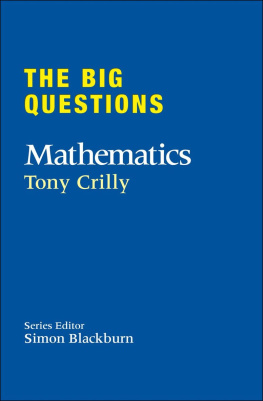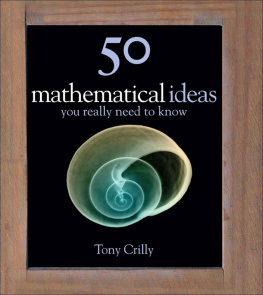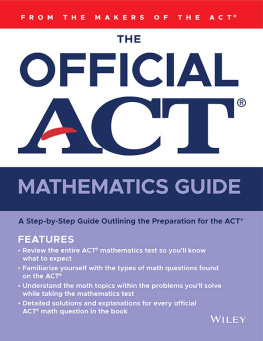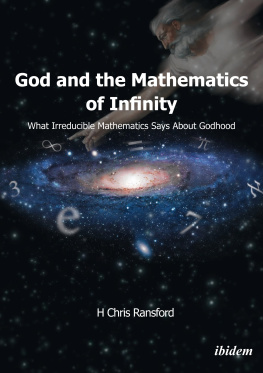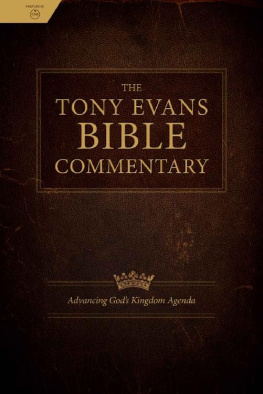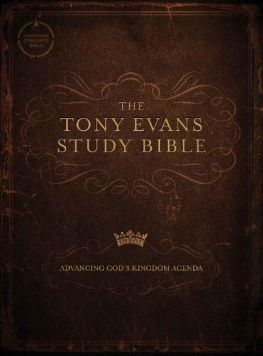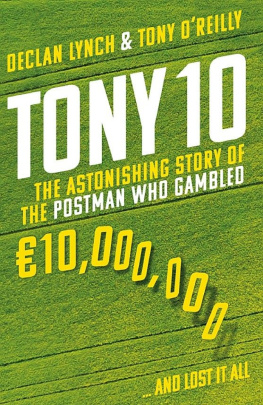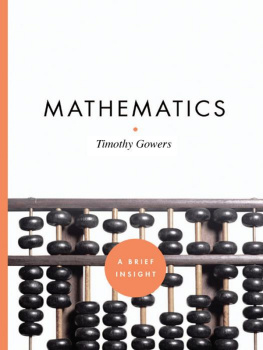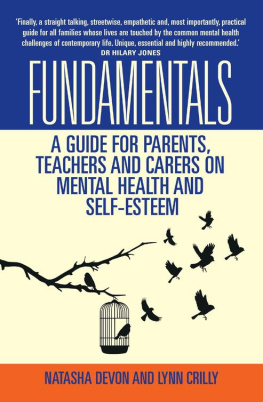Tony Crilly - The Big Questions: Mathematics
Here you can read online Tony Crilly - The Big Questions: Mathematics full text of the book (entire story) in english for free. Download pdf and epub, get meaning, cover and reviews about this ebook. year: 2011, publisher: Quercus, genre: Children. Description of the work, (preface) as well as reviews are available. Best literature library LitArk.com created for fans of good reading and offers a wide selection of genres:
Romance novel
Science fiction
Adventure
Detective
Science
History
Home and family
Prose
Art
Politics
Computer
Non-fiction
Religion
Business
Children
Humor
Choose a favorite category and find really read worthwhile books. Enjoy immersion in the world of imagination, feel the emotions of the characters or learn something new for yourself, make an fascinating discovery.
- Book:The Big Questions: Mathematics
- Author:
- Publisher:Quercus
- Genre:
- Year:2011
- Rating:3 / 5
- Favourites:Add to favourites
- Your mark:
- 60
- 1
- 2
- 3
- 4
- 5
The Big Questions: Mathematics: summary, description and annotation
We offer to read an annotation, description, summary or preface (depends on what the author of the book "The Big Questions: Mathematics" wrote himself). If you haven't found the necessary information about the book — write in the comments, we will try to find it.
The Big Questions: Mathematics — read online for free the complete book (whole text) full work
Below is the text of the book, divided by pages. System saving the place of the last page read, allows you to conveniently read the book "The Big Questions: Mathematics" online for free, without having to search again every time where you left off. Put a bookmark, and you can go to the page where you finished reading at any time.
Font size:
Interval:
Bookmark:
Mathematics
Tony Crilly
SERIES EDITOR
Simon Blackburn

Quercus Publishing Plc
21 Bloomsbury Square, London, WC1A 2NS
First published in 2011
Copyright 2011 Tony Crilly
The moral right of Tony Crilly to be identified as the author of this work has been asserted in accordance with the Copyright, Design and Patents Act, 1988.
All rights reserved. No part of this publication may be reproduced, stored in a retrieval system, or transmitted in any form or by any means, electronic, mechanical, photocopying, recording, or otherwise, without the prior permission in writing of the copyright owner and publisher.
Every effort has been made to contact copyright holders. However, the publishers will be glad to rectify in future editions any inadvertent omissions brought to their attention.
Quercus Publishing Plc hereby exclude all liability to the extent permitted by law for any errors or omissions in this book and for any loss, damage or expense (whether direct or indirect) suffered by a third party relying on any information contained in this book.
A catalogue record of this book is available from the British Library
eBook ISBN 978 1 84916 610 2
Print ISBN
UK and associated territories: 978 1 84916 240 1
Canada: 978 1 84866 091 5
Designed by Patrick Nugent
All illustrations and diagrams by Patrick Nugent
10 9 8 7 6 5 4 3 2 1
You can find this and many other great books at:
www.quercusbooks.co.uk
THE BIG QUESTIONS Mathematics
Tony Crilly is Emeritus Reader in Mathematical
Sciences at Middlesex University, having
previously taught at the University of Michigan,
the City University in Hong Kong and the
Open University. His principal research interest
is the history of mathematics, and he has written
and edited many works on fractals, chaos and
computing. He is the author of the acclaimed
biography of the English mathematician Arthur
Cayley and the internationally bestselling
50 Mathematical Ideas You Really Need to Know.
The Big Questions confronts the fundamental problems of science and philosophy that have perplexed enquiring minds throughout history, and provides and explains the answers of our greatest thinkers. This ambitious series is a unique, accessible and concise distillation of humanitys best ideas.
Series editor Simon Blackburn is Professor of Philosophy at the University of Cambridge, Research Professor of Philosophy at the University of North Carolina and one of the most distinguished philosophers of our day.
Titles in The Big Questions series include:
PHILOSOPHY
PHYSICS
THE UNIVERSE
MATHEMATICS
Mathematics is something we should all know about. The school syllabus is one thing and does not excite all but the subject offers much more. A silent partner in scientific applications, it also has fundamental connections with the arts. As part of the human heritage, mathematics is alive and constantly expanding its boundaries; its life is sustained by the Big Questions.
The big questions in mathematics are very varied. Some are initiated by the seismic changes in modern technology, while others originated in Ancient times and reverberate to this day. Some have received a definite answer only to be replaced by new batches of questions, but others have persisted, never retiring, even after centuries on the frontline. Those verging on the philosophical might never be resolved one way or another, but the questions remain fascinating nonetheless.
Such is the way of mathematics. A curious fact is that mathematics advances slowly. While there is a premium on speed in mental arithmetic and tricky little problems at school there is absolutely no advantage gained by being fast in the real business of mathematics. That mathematics does advance is undeniable, but its progress resembles the gradual inevitability of a lava flow more than the Eureka! moment of a great genius.
Mathematics has a distinctive nature that separates it from science. When a scientific theory loses credibility like the once-popular phlogiston to explain why objects burn, or the luminiferous aether to explain the transmission of light it is abandoned. Such theories are past their sell-by dates and placed in sciences history book for antiquarian interest only. In mathematics, things are different. A proven result cannot subsequently be proved false, and so a theorem a proven mathematical fact has an infinite life. Pythagorass theorem about right-angled triangles is true for all time.
Mathematicians today may not write research papers to contribute theorems of the type that Euclid was writing in 300 BC. Yet these works can inspire, and new ways of thinking can be discovered from foundational texts. We may read the Greek mathematician Diophantus on the theory of equations and still learn from it, for some types of equations in Ancient Greece remain unsolved to this day.
This is not to say that time has no effect on mathematical theory and theorems. They are often modified, refined and tailored for a modern context. The tendency in mathematics is for results to be swallowed up by generalization, and their eventual fate is not the dustbin but a footnote to a more general theory.
We live today in exciting times for mathematics. New questions have to take account of the computer age. This is not merely because computers are efficient at adding up columns of figures, but because they challenge our notions of mathematical proof and raise questions on the nature of mathematics. They can deal with algebra and show geometrical shapes and surfaces to advantage.
The Big Questions considered here focus on big issues and tackle the basic questions that need to be addressed. They will show where mathematics has come from, where it has travelled and where it might be going. They all yield answers, though by no means are those answers all cut and dried. They raise the problems that excite mathematicians and tell us how mathematics informs us about the real physical world we live in. And most of all, they demonstrate that mathematics is a living and breathing subject.
In the 21st century, mathematics is a vast and multifaceted subject. It covers such a broad spectrum of activity that it appears scarcely possible to classify all its manifestations within a single subject. At one end of the spectrum, it defines the nuts and bolts of counting, time and money that enable daily life to chug away. At the other end, it can seem a sealed world in which great ivory-towered minds manufacture puzzles of mammoth complexity which they then devote years to trying to solve. At the same time, our politicians consistently tell us we need more mathematicians. What, then, is all this mathematics for, and how does it fit into our world?
The mathematics we live with today had its seeds in early numerical culture traceable to around 3000 BC. Unsurprisingly, the beginnings were geared to dealing with practical matters. Problems of the market place, the payment of taxes, measuring ones land, comprehending the stars and the planets, devising a calendar all were applications requiring numbers, calculation and some rudimentary geometry. But with the Egyptians, a thousand years later, societies began to investigate the properties of their number systems irrespective of obvious applications. They also began to create, out of curiosity and intellectual pleasure, mathematical puzzles, just as we might enjoy the Sudoku page in the newspaper. Mathematics had begun to look to itself. The mathematician was born.
Font size:
Interval:
Bookmark:
Similar books «The Big Questions: Mathematics»
Look at similar books to The Big Questions: Mathematics. We have selected literature similar in name and meaning in the hope of providing readers with more options to find new, interesting, not yet read works.
Discussion, reviews of the book The Big Questions: Mathematics and just readers' own opinions. Leave your comments, write what you think about the work, its meaning or the main characters. Specify what exactly you liked and what you didn't like, and why you think so.

